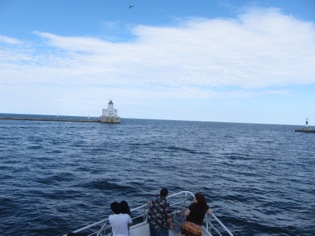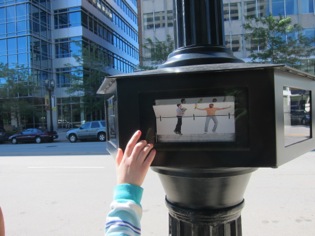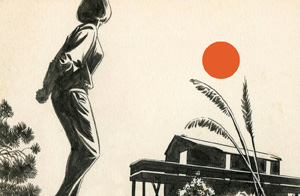A week or so ago, when I told you about my recent trip to Milwaukee, I promised that there would be a follow-up post, in which I’d talk about fish fries, public art, and the like. Well, I’m afraid that I’ve put it off so long now that I can’t quite remember what it was that I wanted to convey to you. Seeing as how I promised, though, I’m going to go ahead and give it a shot. You should know, however, that what you’re about to read very likely won’t attain the same level of quality that readers of this site have come to expect over the past decade.
 FISH: Milwaukee is famous for its fish fries. Apparently, Lake Michigan, before the pollution, overfishing and introduction of invasive species, used to be just teeming with delicious fish, like walleye and perch. The honest, hardworking inhabitants of Milwaukee, a good number of whom were first-generation German Catholics, would pull them from Lake Michigan by the bushel, coat them in goop, deep-fry them until golden brown, gobble them up with tartar sauce and potato pancakes, and wash them down with copious amounts of beer. This was especially true on Fridays, when, due to a religious edict I’ve never quite been able to make sense of, Catholics aren’t allowed to consume the flesh of non-aquatic creatures. And thus a tradition was born that lives on to today, in spite of the fact that almost all the fish consumed at Milwaukee’s Friday night fish fries, which still number over 1,000, are now trucked or flown in from elsewhere.
FISH: Milwaukee is famous for its fish fries. Apparently, Lake Michigan, before the pollution, overfishing and introduction of invasive species, used to be just teeming with delicious fish, like walleye and perch. The honest, hardworking inhabitants of Milwaukee, a good number of whom were first-generation German Catholics, would pull them from Lake Michigan by the bushel, coat them in goop, deep-fry them until golden brown, gobble them up with tartar sauce and potato pancakes, and wash them down with copious amounts of beer. This was especially true on Fridays, when, due to a religious edict I’ve never quite been able to make sense of, Catholics aren’t allowed to consume the flesh of non-aquatic creatures. And thus a tradition was born that lives on to today, in spite of the fact that almost all the fish consumed at Milwaukee’s Friday night fish fries, which still number over 1,000, are now trucked or flown in from elsewhere.
According to the fellow doing the speaking on the boat tour we took down the Milwaukee River and into Lake Michigan, there’s presently not a single commercial fisherman in Milwaukee. While sport fishing is apparently a huge business, due to the fact that the Department of Natural Resources continues to stock Lake Michigan with salmon, almost everything else that’s wroth a damn is gone. The perch population, we were told, collapsed with the introduction of zebra mussels, which made their way from Asia to the Great Lakes in the ballast tanks of ships. (Apparently zebra mussels and perch compete for the same food supply, and zebra mussels invariably win.) The only fish that seems to be doing well are the alewife, which are also invasive. (The reason, I’m told, that the Department of Natural Resources began stocking Lake Michigan with salmon is that they eat a ton of alewife. Thankfully, though, they appear not to reproduce in the Lake, which is why they need to keep being restocked.)
[note: My people – the Scandinavians who settled not too far from Milwaukee – also loved eating fish. They, however, boiled theirs, along with potatoes and salt, in large cauldrons. As fried fish tastes a damn site better, it’s not terribly surprising that, today, there’s not a single Friday night white fish boil, while fish fries can be found on every corner. At any rate, I thought that it was worth a mention that my ancestors lost out, and deservedly so, in this epic battle for hearts, minds and stomachs in the New World… While we’re on the subject, my grandmother still remembers, as a little girl in Galesburg, Illinois, when the door-to-door eel salesman would come to the Jacobson household with his sack full of eels, around the holidays. She says it was godawful. She and her sister would run up to their bedroom and bury their faces in their pillows in hopes of avoiding the smell… While I’m proud of my Swedish ancestry, I think certain traditions are probably better put behind us.]
On this trip to Milwaukee, we had our fried fish at a historic, old place called Turner Hall. Sadly, so much time has passed now that I can’t comment on the food. I do recall liking the place, though… Oh, here’s a hint for you, in case you ever decide to go. If there’s a line winding around the block, full of fourteen year old blonde girls in short skirts, don’t just assume that they’re there for the fish fry and queue up behind them. If you do, you’ll likely be embarrassed when the manager of the joint comes out, looks at you like you’re stupid, and tells you, “You and them aren’t going the same place. They ain’t here for the fish fry.” In this particular case, the girls were waiting for an execrable little pop singer who calls himself Passenger.
Before we move on, I wanted to share something that I overheard while inside Turner Hall, walking around with Arlo, trying to keep him occupied while were were waiting for our food. We were passing through the bar when I overheard an older fellow and a younger fellow talking about all the girls making their way upstairs to see the show. The younger guy, who was probably about 30, said something like, “Girls today, huh?” The older guy looked at him and said quite matter-of-factly, “They’re no different now than they were in the 50’s. You should have seen ’em around Sinatra.”
Oh, and speaking of pollution in Lake Michigan, did you hear about the most recent nuclear plant spill? While I’d like to think that it’ll lead to enormous, tasty walleye, I suspect it’ll just mean more mutated alewife with open sores.
 PUBLIC ART: I don’t know how they came up with the money to do it, but Milwaukee is full of public art. They’ve got park benches that you can beat with mallets to make music, and big metal pieces that you can pour handfuls of gravel through. Since my last visit, they’ve added a series of animated vignettes to the light poles surrounding the Milwaukee Art Museum. They’re kind of like flip books… As it’s a difficult idea to convey, I shot a little video…. Here it is.
PUBLIC ART: I don’t know how they came up with the money to do it, but Milwaukee is full of public art. They’ve got park benches that you can beat with mallets to make music, and big metal pieces that you can pour handfuls of gravel through. Since my last visit, they’ve added a series of animated vignettes to the light poles surrounding the Milwaukee Art Museum. They’re kind of like flip books… As it’s a difficult idea to convey, I shot a little video…. Here it is.
The individual pieces, as I understand it, were scripted with input from the people of Milwaukee, and the actors are just local folks who showed up at open casting calls. I think that’s kind of beautiful… I know something like this would never fly in Ypsilanti, where we can barely keep our street lights lit at it is, but one does wish that there were a way to incorporate more public art into our lives here… Actually, I’m working on a related post right now, prompted by a letter from a reader about wheatpasting. He wanted to know whether or not affixing art to buildings using wheatpaste was viewed any more favorably by our police than spray painting. I reached out to a few people and began reading through the legislation, and what I found was kind of interesting. Apparently, according to statute, you can only post things on the kiosks which have been erected around town for the purpose of sharing information. The only problem is, no such kiosks exist… Like I said, you can expect a longer post on the subject sometime in the future. I just wanted to vent a little now, though, as it’s frustrating living in a town that not only doesn’t have public art to speak of, but doesn’t even have a way for community members to share ideas, artistic or otherwise, in public… And, when I say that Ypsi doesn’t have public art, I mean officially. There is, of course, our unsanctioned sculpture garden on Water Street, which, by the way, has a new piece as of a few days ago.
 FOLKART: The Milwaukee Art Museum, in addition to have a very nice modern art collection, which I think I mentioned in my previous post, has a pretty cool little folk art exhibition, that includes a number of pieces by my old friend Howard Finster. I was particularly struck this time by a transplanted section of a folk art environment by the name of Possum Trot, which was the work of a fellow by they name of Calvin Black, and his wife, Ruby. Beginning in 1950, and working until 1972, the pair had made several hundred performing wooden dolls for their roadside attraction in the California desert. (Calvin did the carving, and Ruby made the dresses.) The following excerpt is from the Milwaukee Art Museum’s webpage dedicated to Possum Trot:
FOLKART: The Milwaukee Art Museum, in addition to have a very nice modern art collection, which I think I mentioned in my previous post, has a pretty cool little folk art exhibition, that includes a number of pieces by my old friend Howard Finster. I was particularly struck this time by a transplanted section of a folk art environment by the name of Possum Trot, which was the work of a fellow by they name of Calvin Black, and his wife, Ruby. Beginning in 1950, and working until 1972, the pair had made several hundred performing wooden dolls for their roadside attraction in the California desert. (Calvin did the carving, and Ruby made the dresses.) The following excerpt is from the Milwaukee Art Museum’s webpage dedicated to Possum Trot:
…Calvin based his characters both on celebrities and friends, creating distinctive personalities for each doll, like “Miss Mary Ripple”… He engineered a dedicated performance space, the Birdcage Theatre, for the wooden ladies, whom he rigged to move through various mechanical devices. In addition, Calvin wrote and recorded speeches and songs for each doll, which he played for the guests as a revue… In the original revue, customers were able to give each doll tips, which the Blacks used to buy jewelry, perfume, and trinkets for the most popular performers…
And, here, because you have to hear Calvin’s voice, is a bit of video that I shot of the “ladies” performing.
OK, I’m sure there’s more I could say about Milwaukee, but, as I’m falling asleep, I’m going to call it quits here. I hope that, between the two posts, I was able to at least pique your interest a bit. It really is a cool, little city, and I’d encourage you to check it out.
note: While I’ve never come across one in all my travels across the Midwest, I’ve been assured by several readers of this site that public fish boils do in fact still exist. So, I guess, my comment about how we Scandinavians ceded victory to the fish friers of the world was wrong. I still, maintain, however, that it’s just a matter of time. There is no way that a boiled fish can possibly compete with a fried one. Of this I am certain.












10 Comments
FWIW, my peoples come from north of there near Door County, and I can testify based on a recent trip back that if you go up there, the fish boil is alive and well. The one we went to was pretty good too, though instead of one of the traditional lake fish, they used cod, which might be the reason it tasted good.
Can someone please tell me what the man is saying in the Possum Trot video? I keep trying and I can’t understand him.
ah right – what Steve said – boils are alive and well. And they are certainly better than most of the ‘fries’. Some may argue otherwise but I’m pretty sure the frying came in with the trucking and flying of fish. Fresh stuff doesn’t need to be treated so roughly.
From an NPR story on Catholics and the eating of fish on Fridays:
It sounds like the plot of a Dan Brown thriller: A powerful medieval pope makes a secret pact to prop up the fishing industry that ultimately alters global economics. The result: Millions of Catholics around the world end up eating fish on Fridays as part of a religious observance.
This “realpolitik” explanation of why Catholics eat fish on Friday has circulated for so long, many people grew up believing it as fact. Some, myself included, even learned it in Catholic school. It’s a humdinger of a tale — the kind conspiracy theorists can really sink their teeth into. But is it true?
“Many people have searched the Vatican archives on this, but they have found nothing,” says Brian Fagan, a professor emeritus of archaeology at the University of California, Santa Barbara, whose book, Fish On Friday, explores the impact of this practice on Western culture.
The real economic story behind fish on Fridays turns out to be much better.
Let’s start with a quick lesson in theology: According to Christian teaching, Jesus died on a Friday, and his death redeemed a sinful world. People have written of fasting on Friday to commemorate this sacrifice as early as the first century.
Technically, it’s the flesh of warmblooded animals that’s off limits — an animal “that, in a sense, sacrificed its life for us, if you will,” explains Michael Foley, an associate professor at Baylor University and author of Why Do Catholics Eat Fish On Friday?
Fish are coldblooded, so they’re considered fair game. “If you were inclined to eat a reptile on Friday,” Foley tells The Salt, “you could do that, too.”
Alas, Christendom never really developed a hankering for snake. But fish — well, they’d been associated with sacred holidays even in pre-Christian times. And as the number of meatless days piled up on the medieval Christian calendar — not just Fridays but Wednesdays and Saturdays, Advent and Lent, and other holy days — the hunger for fish grew. Indeed, fish fasting days became central to the growth of the global fishing industry. But not because of a pope and his secret pact.
At first, says Fagan, Christians’ religious appetite was largely met with herring, a fish that was plentiful but dry and tasteless when smoked or salted. And preservation was a must in medieval times: There was no good way for fresh fish to reach the devout masses. Eventually, cod became all the rage — it tasted better when cured and it lasted longer, too.
The Vikings were ace at preserving cod — they “used dried and salted cod as a form of beef jerky on their ocean passages,” Fagan says. And the route the Vikings took at the end of the first millennium — Greenland, Iceland, Newfoundland — matches up with the natural range of the Atlantic cod.
It’s possible that others may have followed the cod trail to Canada before Columbus sailed the ocean blue. Clues suggest that English fishermen from Bristol may have made the voyage by around 1480 but kept mum on the location lest the competition rush in. By some accounts, both Columbus and John Cabot had heard of these adventures when they set off on their own epic journeys west.
“Why do people go over the horizon?” Fagan says. “In the case of the North Atlantic after the Norse … they went looking for cod” to satiate the demands of the faithful.
So that’s the empire part of our saga. Funny enough, while the pope story is a fish tale, an official leader of a church did make fish fasting the law for purely practical reasons. For that story — and the lust our headline promised — we turn to a monarch known for his carnal cravings: Henry VIII.
By the time Henry ascended the throne in 1509, fish dominated the menu for a good part of the year. As one 15th century English schoolboy lamented in his notebook: “Though wyll not beleve how werey I am off fysshe, and how moch I desir to that flesch were cum in ageyn.”
But after Henry became smitten with Anne Boleyn, English fish-eating took a nosedive.
You see, Henry was desperate with desire for Anne — but Anne wanted a wedding ring. The problem was, Henry already had a wife, Catherine of Aragon, and the pope refused to annul that decades’ long marriage. So Henry broke off from the Roman Catholic Church, declared himself the head of the Church of England and divorced Catherine so he could marry Anne.
Suddenly, eating fish became political. Fish was seen as a ” ‘popish flesh’ that lost favour as fast as Anglicism took root,” as Kate Colquhoun recounts in her book Taste: The Story of Britain Through Its Cooking.
Fishermen were hurting. So much so that when Henry’s young son, Edward VI, took over in 1547, fast days were reinstated by law — “for worldly and civil policy, to spare flesh, and use fish, for the benefit of the commonwealth, where many be fishers, and use the trade of living.”
In fact, fish fasting remained surprisingly influential in global economics well into the 20th century.
As one economic analysis noted, U.S. fish prices plummeted soon after Pope Paul VI loosened fasting rules in the 1960s. The Friday meat ban, by the way, still applies to the 40 days of the Lenten fast, which ends this Saturday.
A few years before the Vatican relaxed the rules, Lou Groen, an enterprising McDonald’s franchise owner in a largely Catholic part of Cincinnati, found himself struggling to sell burgers on Fridays. His solution? The Filet-O-Fish.
While not exactly the miracle of loaves and fishes, Groen’s little battered sandwich has fed millions around the world.
I’m happy to be corrected concerning the ongoing existence of public fish boils. I will add a note at the end of the post. And I will try to transcribe what Calvin says in the video.
I still maintain, however, that Scandinavians cannot be trusted with fish.
” would never fly in Ypsilanti, where we can barely keep our street lights lit at it is, but one does wish that there were a way to incorporate more public art into our lives here”
Out of curiosity…
It looks like City of Milwaukee has a total annual budget of about $1.5 billion, for about 600,000 people, or about $2,500 per capita.
City of Ypsilanti’s total annual budget is about $19 million, for 19,500 people, or about $975 per capita.
Having more than twice as much money to spend per person might help explain how the city can afford public art.
Within their budget, it looks like they have a city arts board, with city staff and $150,000+ in annual grants to artists. (Their County also appears to have a public arts budget.)
I’d heard of Possum Trot, but I wasn’t aware that each of the dolls got her own tips, which were then spent on her. That blows my mind.
The dolls are like strippers.
Please tell me the next time you are in Milwaukee as I want to get pregnant by a blogger. If it helps, I can begin charting my basal temperature here. Just let me know.